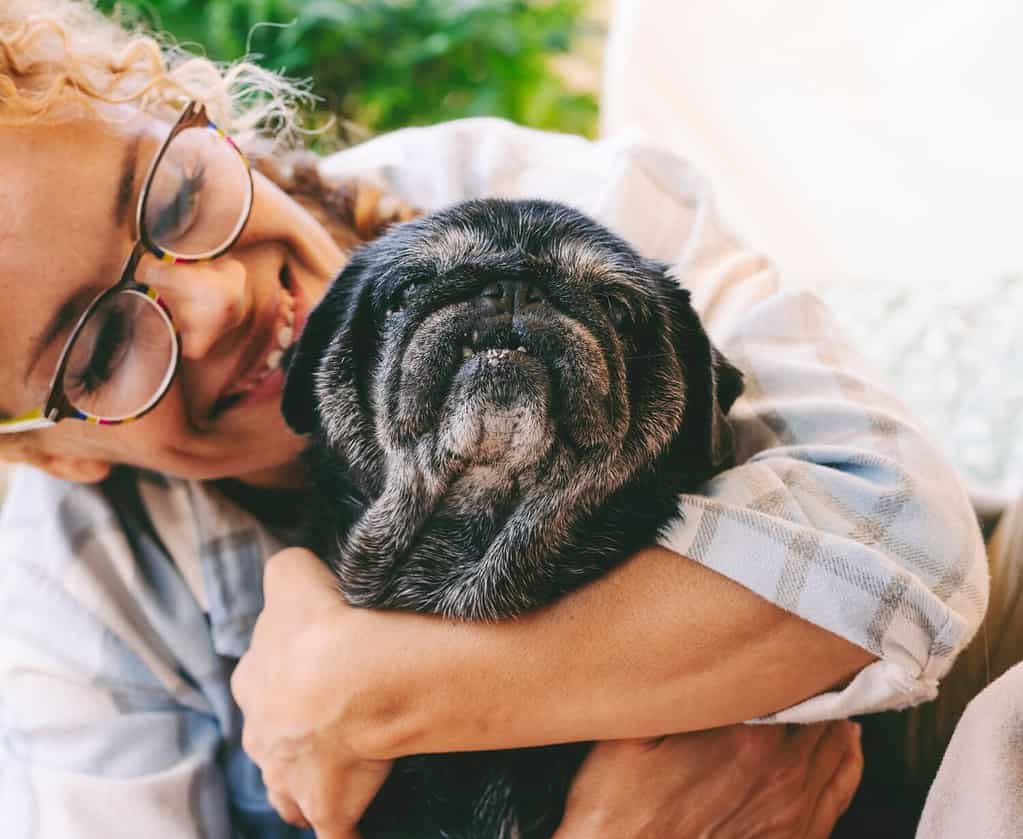There are many, many things to love about pugs. These furry friends are naturally kind and intelligent and have an earnest desire to both be loved and to love on you! But, despite their huge and seemingly indestructible personalities, they do have an unfortunate slew of health issues that owners should be well aware of. This list of pug health problems isn’t meant to startle or concern you but rather to be sure that you know what you’re in for. Having any pet is a commitment, and part of that commitment is not being ignorant of potential issues that they might experience.
That’s why, in this article, you’ll learn ten of the most common health issues that pugs experience, as well as gain a better understanding of how you can look out for early signs of these illnesses and act fast.
Are Pugs Prone to Health Issues?

While their brachycephalic traits might look adorable, they can have serious health consequences for pugs.
©220 Selfmade studio/Shutterstock.com
There are a lot of distinct, distinguishing features that pugs possess. These include things like their lovably flat face, bulging eyes, and curly tails. While these might all be features that we consider to be cute, the issues that they can present for the pug’s health are not cute in the slightest. All of these traits, which have been intentionally bred into pugs, have resulted in an increased array of obstacles that pugs have to deal with throughout their lives.
These issues are so severe, in fact, that a study from the Royal Veterinary College in the UK in 2022 revealed that the scope of pug health problems makes them “substantially different and far worse” than other breeds. The study revealed that, when compared with other breeds on an annual basis, pugs were nearly twice as likely to experience one or more disorders. Some conditions, they found, pugs were over ten times more likely to experience than other breeds.
These findings beg the question as to whether or not selective breeding on the basis of aesthetics is actually ethical. But, even more so, they bring attention to the fact that pug ownership is a hefty responsibility that all owners should be aware of before adopting. To aid you in this journey of discovery, below are ten of the most common pug health problems.
The Most Common Pug Health Problems

In order to be a responsible pet owner, it’s important to know what kind of illnesses your pet might be vulnerable to.
©TatyanaPanova/Shutterstock.com
1. Brachycephalic Obstructive Airway Syndrome (BOAS)

A common health issue in pugs is BOAS, or Brachycephalic Obstructive Airway Syndrome, which can worsen in the heat.
©sophiecat/Shutterstock.com
The brachycephalic traits that pugs possess, as touched on earlier, result in a number of troubles for pugs. Because of these traits, pugs have a high risk (over 50% higher than that of other breeds) of developing Brachycephalic Obstructive Airway Syndrome, or BOAS. BOAS is a condition that dogs have when they cannot get enough air into their lungs in enough time. This is a result of having a narrow windpipe or nostrils or of having an elongated soft palate. In any case, this illness is one that is lifelong and will progressively worsen with age.
You can get your pug checked for BOAS once they turn one year old. Getting them checked early on is imperative in managing their symptoms. There are certain things that can make your pug especially susceptible to this illness, such as being female or being obese. If you believe that your pug might be suffering from BOAS, look out for the following symptoms:
- Difficulty breathing
- Extreme heat sensitivity
- Trouble running and/or exercising
- Sleep apnea
- Vomiting
- Coughing
Also, be aware that since this illness involves troubled breathing, it is one that can worsen in the summertime. While pugs are already especially vulnerable to the heat, this condition can make excessive heat exposure deadly.
2. Cancer

Pugs have an unfortunate risk of cancer, and it’s the leading cause of death for the breed.
©iStock.com/matt_benoit
Unfortunately, the current leading cause of death for pugs is cancer. In particular, there are two cancers pugs are especially prone to; Oral melanoma and mast cell tumors.
Oral melanoma is something that typically affects senior dogs 12 years of age or older. But, it’s a common pug health problem even from a young age. Pugs have black gums, and as it happens, oral melanoma is far more likely to occur in dogs that have oral mucosa (gums) that have dark pigment. If you find that your pug has been experiencing mouth bleeding, has a strange cheek bulge, or is experiencing a loss of appetite, you should bring them to the vet for an immediate checkup.
The other type, which is Mast cell tumors, is unfortunately harder to diagnose. According to a Veterinary Oncology study, 56% of pugs are or will suffer from MCTs. These develop due to a number of factors. The only real signifier that your dog is suffering from one is that there will be a red, swollen lump on their body. However, this lump will flare up and calm down in a cyclical fashion due to the nature of inflammation. The ‘good’ news is that, after surgical removal, dogs typically recover quite fast. However, in more severe instances (like if the mass forms internally), there will be a need for extended cancer treatment post-removal.
3. Eye Ulcers and Infections

The eyes of a pug are more likely to develop ulcers due to their bulging nature.
©Nature Art/Shutterstock.com
Due to the shape of a pug’s skull, their eye sockets are incredibly shallow. This is why their eyelids cannot fully close and why they have their signature “bug-eyed” appearance. With these bulged eyes come a slew of vulnerabilities for pugs to develop corneal ulcers and other eye-related infections.
A corneal ulcer can develop when your pug’s eye gets agitated in some way by an external force. This can be something like a tree branch or even their own eyelashes. If your pug has chronically dry eyes (something they are also susceptible to), this can also be a cause of one of these ulcers.
You’ll know fairly immediately when a pug is experiencing this kind of ulcer. Their eyes will turn red and cloudy, and you might even see them emit a gooey discharge. They are also incredibly painful, so don’t be surprised if your dog is trying to squint or rub at their eyes.
In terms of treatment, there is a range of severity to these ulcers. Some can be removed with a simple prescriptive topical antibiotic. In more severe cases, where the eye is in danger, there might be a need for surgery that can take six to eight weeks for your pug to recover from. In the worst, most unfortunate cases, the ulcer may be deep enough to cause the pug’s eye to burst. When this happens, they must have their eye surgically removed.
4. Patellar Luxation

Your pug may experience slipped kneecaps or patellar luxation, however, this is curable.
©David Charles Cottam/Shutterstock.com
Patellar luxation is essentially just a fancy, scientific term for slipped kneecaps. When this happens, it can cause limping and severe pain. This is a problem that pugs are susceptible to and could occur via an injury or on a hereditary basis.
This is one of the illnesses on this list that is fortunately curable. There are simple surgeries that will pop the kneecap of the pug back into place, but even so, it is important to keep an eye on them after the fact to ensure they’re not over-exerting themselves.
5. Legg-Calvé-Perthe Disease

If your pug has poor blood flow in his legs, your pug may experience Legg-Calvé-Perthes Disease.
©simona pilolla 2/Shutterstock.com
Caused by issues with blood flow, Legg-Calvé-Perthes Disease is an illness that results in the bones in a dog’s hind legs being disintegrated. This causes pain, of course, in tandem with limping and lameness. Diagnosed by an X-ray, the treatment for this illness usually involves surgically removing the part of the hind-leg bone that has been affected and then waiting for new tissue to form in its stead. After thorough physical therapy and supervised exercise, your dog can certainly make a full recovery from this condition.
6. Dental Diseases

Annual visits to the dentist for cleanings can be a good idea for pugs who are prone to dental diseases like gingivitis.
©220 Selfmade studio/Shutterstock.com
Despite their tiny faces (and jaws), pugs actually have the same amount of teeth that other dogs do. Because of their limited space, these teeth will be very crowded within the pug’s mouth. When teeth are crooked and squished together in such a way, the mouth becomes more vulnerable to conditions like gingivitis.
This is why pugs should get their teeth brushed daily or at least every other day. Taking an annual trip to the doggy dentist is also recommended because this will help you get the earliest possible diagnosis of any developing issues. If there is an instance of diseased teeth, then surgery will be likely. Luckily, these issues are preventable with diligent maintenance.
7. Encephalitis

Pugs are sadly prone to encephalitis, or inflammation of the brain.
©Africa Studio/Shutterstock.com
Like other smaller breeds, such as Chihuahuas and Yorkshire terriers, pugs are susceptible to encephalitis. Though this is still not a well-understood condition, it is still one that involves brain inflammation and results in seizures, changed behavior, blindness, and death. Note that this condition affects only 1% of the pug population. It also develops mostly in young dogs, those 18 months to two years of age. A genetic condition, it is unknown what the exact cause is. It may be hereditary, but this is not proven.
8. Hemivertebrae

Pugs may experience spinal issues due to incorrectly shaped vertebrae.
©TanyaCPhotography/Shutterstock.com
Due to the corkscrew-shaped tail that pugs possess, they might experience a spinal issue like hemivertebrae. This is when there is pressure placed on the dog’s spinal cord from vertebrae that are shaped incorrectly. This causes severe pain and, eventually, incontinence and a loss of use of their back legs. When diagnosed, treatment may either be medication-based or require corrective surgery.
9. Skin Dermatitis

To help them from getting skin infections, it’s a good idea to properly bathe your pug regularly.
©220 Selfmade studio/Shutterstock.com
You might love the wrinkles on your pug, but they also have a high risk of infection. This isn’t something specific to pugs, as many other dog breeds with similar skin folds are likely to develop this. When your pug begins showing symptoms like scratching or licking at the skin, as well as omitting a nasty odor, you should get them checked. If left untreated, this simple infection can snowball into something much more severe. The infected area will develop pus and slime, and your pug might also have tremors and decreased appetite.
Treatment involves a few rounds of antibiotics and antifungals. If your pug has these kinds of infections on a regular basis, you might be recommended a certain kind of medicated spray or shampoo. These kinds of pug health problems can be avoided with daily cleansing with medicated wipes. Another way to help your pug is regular baths, which you should be sure to dry thoroughly after!
10. Hip Dysplasia

The earliest signs of hip dysplasia in pugs are during the puppy stage, and if noticed early, it can be easier to manage.
©Ezzolo/Shutterstock.com
Hip dysplasia is an illness most commonly associated with large dog breeds. Yet, it is one that affects 71% of pugs. Essentially, as a dog grows, so does its hip joint. Hip dysplasia occurs when the ball and socket joints don’t grow at the same time, and there is a looseness in the area. This causes dogs to have a limp and will eventually lead to osteoarthritis or a kind of degenerative disease in their joints.
Initial signs of this can be seen in the first few months of a pug’s life, but it’s most likely to come into play when they are a year or two old. When you first notice the signs, early intervention is key. But, if you get it diagnosed early and the case is not severe, they can live fairly pain-free lives with the help of anti-inflammatory medications and supplements.
The photo featured at the top of this post is © simona pilolla 2/Shutterstock.com
Ready to discover the top 10 cutest dog breeds in the entire world?
How about the fastest dogs, the largest dogs and those that are -- quite frankly -- just the kindest dogs on the planet? Each day, AZ Animals sends out lists just like this to our thousands of email subscribers. And the best part? It's FREE. Join today by entering your email below.
Thank you for reading! Have some feedback for us? Contact the AZ Animals editorial team.







